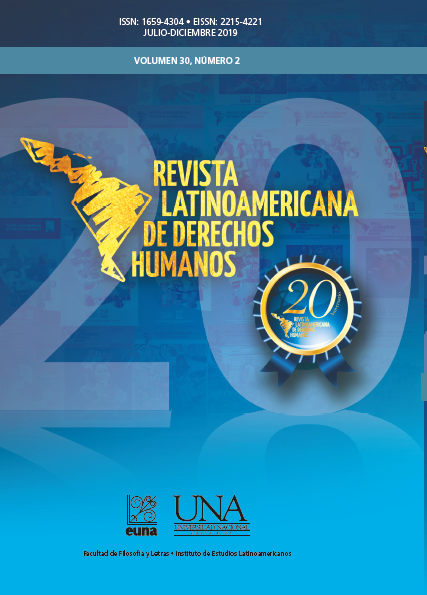The principle of permanent sovereignty of indigenous peoples over resources in their territories
DOI:
https://doi.org/10.15359/rldh.30-2.2Keywords:
Self-determination; Sovereignty; Natural resources; Indigenous peoples.Abstract
The need for States to access natural resources in indigenous territories has led to confrontations between different rights and principles established in Public International Law. The purpose of the present article is to analyze the conflicts between the principle of permanent sovereignty over natural resources and the right of indigenous peoples to self-determination. On the one hand, the principle of permanent sovereignty over natural resources is a means to guarantee a State’s access to resources to drive their development model. On the other hand, the right to self-determination allows indigenous peoples to access the resources necessary for their economic, social and cultural development. The implementation of extractive projects in indigenous territories has resulted in the deprivation of their territory as well as the limitation of access to resources, including those indispensable for subsistence. This has significantly undermined their right to freely determine their own development model, and even to warrant their survival as indigenous peoples. Given this reality, the article raises the idea of an inclusive and not only exclusive sovereignty of the State, through which indigenous peoples may secure and protect their access to the necessary resources for their development.
References
Anaya, J. (2004). Indigenous Peoples in International Law. Nueva York: Oxford University Press.
Capotorti, F. (1979). Study on the rights of persons belonging to ethnic, religious and linguistic minorities. UN Doc E/CN.4/Sub.2/384/Rev.1. Recuperado de https://digitallibrary.un.org/record/10387
Comité de Derechos Humanos. (1984). Observación General n.o 12, Derecho de libre determinación. Recuperado de https://conf-dts1.unog.ch/1%20SPA/Tradutek/Derechos_hum_Base/CCPR/00_2_obs_grales_Cte%20DerHum%20%5BCCPR%5D.html#GEN12
Corte International de Justicia. (1971). Legal Consequences for States of the continued presence of South Africa in Namibia (South West Africa) Advisory Opinion. Recuperado de https://www.icj-cij.org/files/case-related/53/5597.pdf
Corte Permanente de Justicia Internacional. (1930). Advisory Opinion in the Greco-Bulgarian “Communities”. Recuperado de https://www.icj-cij.org/files/permanent-court-of-international-justice/serie_B/B_17/01_Communautes_greco-bulgares_Avis_consultatif.pdf
Daes, E. (2004). Informe final de la relatora especial sobre la soberanía permanente de los pueblos indígenas sobre sus recursos naturales. U.N. Doc. E/CN.4/Sub 2/2004/30. Recuperado de http://hrlibrary.umn.edu/demo/IndigenousSovereigntyNaturalResources_Daes.pdf
EC. (2008). Constitución de la República del Ecuador. Registro Oficial 449, 20 de octubre.
Herdegen, M. (2005). Derecho internacional público. México: Universidad Autónoma de México.
Informe de Comisión Interamericana de Derechos Humanos de 24 de abril de 1997. Informe sobre la situación de los derechos humanos en Ecuador. Recuperado de http://www.cidh.org/countryrep/Ecuador-sp/indice.htm
Informe de la Comisión Interamericana de Derechos Humanos de 27 de diciembre de 2002. Caso Mary y Carrie Dann. Recuperado de http://www.cidh.oas.org/Indigenas/EEUU.11.140.htm
McCorquodale, R. (1994). Self-Determination: A Human Rights Approach. The International and Comparative Law Quarterly, 43(4).
Oficio Dirección Nacional de Registro Civil, Identificación y Cedulación del Ecuador de19 de octubre de 2017. Oficio n.o DIGERCIC-CGAJ.DPN-2017-0011-O. Recuperado de https://twitter.com/ecuachaskiecua/status/921411843394023424
OIT. (1989). Convenio 169 Sobre pueblos indígenas y tribales. Autor.
ONU Asamblea General. (1952a). Derecho a explotar libremente las riquezas y recursos naturales. A/RES/626 (VII). Recuperado de https://undocs.org/es/A/RES/626(VII)
ONU Asamblea General. (1952b). Desarrollo económico integrado y acuerdos comerciales. A/RES/523 (VI). Recuperado de https://undocs.org/es/A/RES/523(VI)
ONU Asamblea General. (1960a). Acción concertada en pro del desarrollo económico de los países económicamente poco desarrollados. A/RES/1515(XV). Recuperado de https://undocs.org/es/A/RES/1515(XV)
ONU Asamblea General. (1960b). Declaración sobre la concesión de la independencia a los países y pueblos coloniales. A/RES/1514(XV). Recuperado de https://undocs.org/es/A/RES/1514(XV)
ONU Asamblea General. (1962). Soberanía permanente sobre los recursos naturales. A/RES/1803(XVII). Recuperado de https://undocs.org/es/A/RES/1803(XVII)
ONU Asamblea General. (1966 a). Pacto Internacional de Derechos Civiles y Políticos. Autor.
ONU Asamblea General. (1966 b). Pacto Internacional de Derechos Económicos, Sociales y Culturales. Autor.
ONU Asamblea General. (1970). Declaración relativa a los principios de derecho internacional referentes a las relaciones de amistad y a la cooperación entre los Estados de conformidad con la Carta de las Naciones Unidas. A/RES/2625 (XXV). Recuperado de https://www.dipublico.org/doc/A-RES-2625(XXV).pdf
ONU Asamblea General. (1986). Declaración sobre el derecho al desarrollo. A/RES/41/128. Recuperado de https://undocs.org/es/A/RES/41/128
ONU Asamblea General. (2007). Declaración de las Naciones Unidas sobre los derechos de los pueblos indígenas.
ONU Secretario General de Naciones Unidas. (1955). Draft international covenant on human rights. A/2929. Recuperado de https://www2.ohchr.org/english/issues/opinion/articles1920_iccpr/docs/A-2929.pdf
ONU. (1945). Carta de Naciones Unidas. Autor.
Reports of International Arbitral Awards de 4 de abril 1928. Island of Palmas Case (Netherlands, USA). Recuperado de http://legal.un.org/riaa/cases/vol_II/829-871.pdf
Schrijver, N. J. (1997). Sovereignty over natural resources: balancing rights and duties in an interdependent world. Cambrige: Cambrige University Press.
Sentencia Corte Constitucional del Ecuador de 30 de julio de 2014. Sentencia n.o 113-14-SEP-CC. Recuperado de http://portal.corteconstitucional.gob.ec/Raiz/2014/113-14-SEP-CC/REL_SENTENCIA_113-14-SEP-CC.pdf
Sentencia Corte Interamericana de Derechos Humanos de 28 de noviembre de 2007. Caso Pueblo Saramaka vs. Surinam. Recuperado de http://www.corteidh.or.cr/docs/casos/articulos/seriec_172_esp.pdf
Sentencia de Corte Suprema de Estados Unidos de 18 de marzo de 1832. Samuel A. Worcester Plaintiff in Error v. The State of Georgia, 31 U.S. 515, 6 Pet. 515, 8 L.Ed. 483. Recuperado de https://www.courtlistener.com/opinion/85797/worcester-v-georgia/
Thornberry, P. (1989). Self-Determination, Minorities, Human Rights: A Review of International Instruments. The International and Comparative Law Quarterly, 38(4).
Downloads
Published
How to Cite
Issue
Section
License
El material que se publica en esta Revista está bajo una licencia “Creative Commons” 3.0 Costa Rica (CC, Reconocimiento-NoComercial-SinObraDerivada 3.0 Costa Rica (CC BY-NC-ND 3.0 CR) . Esto significa que el material publicado en la revista se puede compartir (copiar y distribuir) en cualquier medio o formato considerando que se debe reconocer de forma adecuada la autoría del material y la fuente, no puede utilizarse con fines comerciales y no se aceptan las obras derivadas (remezclar, transformar o crear a partir del material).








